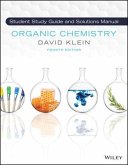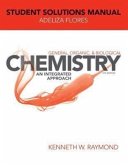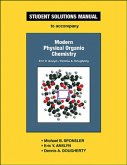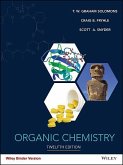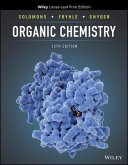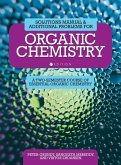T W Graham Solomons, Craig B Fryhle, Scott A Snyder
Organic Chemistry, 12e Binder Ready Version Study Guide & Student Solutions Manual
T W Graham Solomons, Craig B Fryhle, Scott A Snyder
Organic Chemistry, 12e Binder Ready Version Study Guide & Student Solutions Manual
- Loseblattsammlung
- Merkliste
- Auf die Merkliste
- Bewerten Bewerten
- Teilen
- Produkt teilen
- Produkterinnerung
- Produkterinnerung
This is the Student Study Guide/Solutions Manual to accompany Organic Chemistry, 12th Edition. The 12th edition of Organic Chemistry continues Solomons, Fryhle & Snyder's tradition of excellence in teaching and preparing students for success in the organic classroom and beyond. A central theme of the authors' approach to organic chemistry is to emphasize the relationship between structure and reactivity. To accomplish this, the content is organized in a way that combines the most useful features of a functional group approach with one largely based on reaction mechanisms. The authors'…mehr
Andere Kunden interessierten sich auch für
![Organic Chemistry, 4e Student Solution Manual and Study Guide Organic Chemistry, 4e Student Solution Manual and Study Guide]() David R KleinOrganic Chemistry, 4e Student Solution Manual and Study Guide156,99 €
David R KleinOrganic Chemistry, 4e Student Solution Manual and Study Guide156,99 €![General, Organic, and Biological Chemistry: An Integrated Approach, 4e Student Solutions Manual General, Organic, and Biological Chemistry: An Integrated Approach, 4e Student Solutions Manual]() Kenneth W RaymondGeneral, Organic, and Biological Chemistry: An Integrated Approach, 4e Student Solutions Manual106,99 €
Kenneth W RaymondGeneral, Organic, and Biological Chemistry: An Integrated Approach, 4e Student Solutions Manual106,99 €![Anslyn & Dougherty's Modern Physical Organic Chemistry Student Solutions Manual Anslyn & Dougherty's Modern Physical Organic Chemistry Student Solutions Manual]() Michael B SponslerAnslyn & Dougherty's Modern Physical Organic Chemistry Student Solutions Manual79,99 €
Michael B SponslerAnslyn & Dougherty's Modern Physical Organic Chemistry Student Solutions Manual79,99 €![Organic Chemistry with Biological Applications, Loose-Leaf Version Organic Chemistry with Biological Applications, Loose-Leaf Version]() John McmurryOrganic Chemistry with Biological Applications, Loose-Leaf Version244,99 €
John McmurryOrganic Chemistry with Biological Applications, Loose-Leaf Version244,99 €![Organic Chemistry Organic Chemistry]() T W Graham SolomonsOrganic Chemistry177,99 €
T W Graham SolomonsOrganic Chemistry177,99 €![Organic Chemistry Organic Chemistry]() T W Graham SolomonsOrganic Chemistry177,99 €
T W Graham SolomonsOrganic Chemistry177,99 €![Solutions Manual and Additional Problems for Organic Chemistry Solutions Manual and Additional Problems for Organic Chemistry]() Viktor ZhdankinSolutions Manual and Additional Problems for Organic Chemistry136,99 €
Viktor ZhdankinSolutions Manual and Additional Problems for Organic Chemistry136,99 €-
-
-
This is the Student Study Guide/Solutions Manual to accompany Organic Chemistry, 12th Edition. The 12th edition of Organic Chemistry continues Solomons, Fryhle & Snyder's tradition of excellence in teaching and preparing students for success in the organic classroom and beyond. A central theme of the authors' approach to organic chemistry is to emphasize the relationship between structure and reactivity. To accomplish this, the content is organized in a way that combines the most useful features of a functional group approach with one largely based on reaction mechanisms. The authors' philosophy is to emphasize mechanisms and their common aspects as often as possible, and at the same time, use the unifying features of functional groups as the basis for most chapters. The structural aspects of the authors' approach show students what organic chemistry is. Mechanistic aspects of their approach show students how it works. And wherever an opportunity arises, the authors' show students what it does in living systems and the physical world around us.
Hinweis: Dieser Artikel kann nur an eine deutsche Lieferadresse ausgeliefert werden.
Hinweis: Dieser Artikel kann nur an eine deutsche Lieferadresse ausgeliefert werden.
Produktdetails
- Produktdetails
- Verlag: Wiley
- 12th edition
- Seitenzahl: 752
- Erscheinungstermin: 11. April 2016
- Englisch
- Abmessung: 274mm x 211mm x 33mm
- Gewicht: 1588g
- ISBN-13: 9781119077336
- ISBN-10: 1119077338
- Artikelnr.: 44272195
- Herstellerkennzeichnung
- Produktsicherheitsverantwortliche/r
- Europaallee 1
- 36244 Bad Hersfeld
- gpsr@libri.de
- Verlag: Wiley
- 12th edition
- Seitenzahl: 752
- Erscheinungstermin: 11. April 2016
- Englisch
- Abmessung: 274mm x 211mm x 33mm
- Gewicht: 1588g
- ISBN-13: 9781119077336
- ISBN-10: 1119077338
- Artikelnr.: 44272195
- Herstellerkennzeichnung
- Produktsicherheitsverantwortliche/r
- Europaallee 1
- 36244 Bad Hersfeld
- gpsr@libri.de
T.W. Graham Solomons did his undergraduate work at The Citadel and received his doctorate in organic chemistry in 1959 from Duke University where he worked with C.K. Bradsher. Following this he was a Sloan Foundation Postdoctoral Fellow at the University of Rachester where he worked with V. Boekelheide. in 1960 he became a charter member of the faculty of the University of South Florida and became Professor of Chemistry in 1973. In 1992 he was made Professor Emeritus. His research interests have been in areas of heterocyclic chemistry and unusual aromatic compounds. He has published papers in the Journal of the American Chemical Society, the Journal of Organic Chemistry, and the Journal of Heterocyclic Chemistry. He has received several awards for distinguished teaching. Craig B. Fryhle is Chair and Professor of Chemistry at Pacific Lutheran University. He earned his B.A. degree from Gettysburg College and Ph.D. from Brown University. His experiences at these institutions shaped his dedication to mentoring undergraduate students in chemistry and the liberal arts, which is a passion that burns strongly for him. His research interests have been in areas relating to the shikimic acid pathway, including molecular modeling and NMR spectrometry of substrates and analogues, as well as structure and reactivity studies of shikimate pathways enzymes using isotopic labeling and mass spectrometry.
Preface
General Introduction
Chapter 1 Structure and Bonding in Organic Molecules
Keys to the Chapter
Solutions to Problems
Chapter 2 Structure and Reactivity: Acids and Bases, Polar and Nonpolar
Molecules
Keys to the Chapter
Solutions to Problems
Chapter 3 Reactions of Alkanes: Bond-Dissociation Energies, Radical
Halogenation, and Relative Reactivity
Keys to the Chapter
Solutions to Problems
Chapter 4 Cycloalkanes
Keys to the Chapter
Solutions to Problems
Chapter 5 Stereoisomers
Keys to the Chapter
Solutions to Problems
Chapter 6 Properties and Reactions of Haloalkanes: Bimolecular Nucleophilic
Substitution
Keys to the Chapter
Solutions to Problems
Chapter 7 Further Reactions of Haloalkanes: Unimolecular Substitution and
Pathways of Elimination
Keys to the Chapter
Solutions to Problems
Chapter 8 Hydroxy Functional Group: Alcohols: Properties, Preparation, and
Strategy of Synthesis
Keys to the Chapter
Solutions to Problems
Chapter 9 Further Reactions of Alcohols and the Chemistry of Ethers
Keys to the Chapter
Solutions to Problems
Chapter 10 Using Nuclear Magnetic Resonance Spectroscopy to Deduce
Structure
Keys to the Chapter
Solutions to Problems
Chapter 11 Alkenes; Infrared Spectroscopy and Mass Spectrometry
Keys to the Chapter
Solutions to Problems
Chapter 12 Reactions of Alkenes
Keys to the Chapter
Solutions to Problems
Chapter 13 Alkynes: The Carbon-Carbon Triple Bond
Keys to the Chapter
Solutions to Problems
Chapter 14 Delocalized Pi Systems: Investigation by Ultraviolet and Visible
Spectroscopy
Keys to the Chapter
Solutions to Problems
Chapter 15 Benzene and Aromaticity: Electrophilic Aromatic Substitution
Keys to the Chapter
Solutions to Problems
Chapter 16 Electrophilic Attack on Derivatives of Benzene: Substituents
Control Regioselectivity
Keys to the Chapter
Solutions to Problems
Chapter 17 Aldehydes and Ketones: The Carbonyl Group
Keys to the Chapter
Solutions to Problems
Chapter 18 Enols, Enolates, and the Aldol Condensation: , -Unsaturated
Aldehydes and Ketones
Keys to the Chapter
Solutions to Problems
Chapter 19 Carboxylic Acids
Keys to the Chapter
Solutions to Problems
Chapter 20 Carboxylic Acid Derivatives
Keys to the Chapter
Solutions to Problems
Chapter 21 Amines and Their Derivatives: Functional Groups Containing
Nitrogen
Keys to the Chapter
Solutions to Problems
Chapter 22 Chemistry of Benzene Substituents: Alkylbenzenes, Phenols, and
Anilines
Keys to the Chapter
Solutions to Problems
Chapter 23 Ester Enolates and the Claisen Condensation: Synthesis of
-Dicarbonyl Compounds; Acyl Anion Equivalents
Keys to the Chapter
Solutions to Problems
Chapter 24 Carbohydrates: Polyfunctional Compounds in Nature
Keys to the Chapter
Solutions to Problems
Chapter 25 Heterocycles: Heteroatoms in Cyclic Organic Compounds
Keys to the Chapter
Solutions to Problems
Chapter 26 Amino Acids, Peptides, Proteins, and Nucleic Acids:
Nitrogen-Containing Polymers in Nature
Keys to the Chapter
Solutions to Problems
General Introduction
Chapter 1 Structure and Bonding in Organic Molecules
Keys to the Chapter
Solutions to Problems
Chapter 2 Structure and Reactivity: Acids and Bases, Polar and Nonpolar
Molecules
Keys to the Chapter
Solutions to Problems
Chapter 3 Reactions of Alkanes: Bond-Dissociation Energies, Radical
Halogenation, and Relative Reactivity
Keys to the Chapter
Solutions to Problems
Chapter 4 Cycloalkanes
Keys to the Chapter
Solutions to Problems
Chapter 5 Stereoisomers
Keys to the Chapter
Solutions to Problems
Chapter 6 Properties and Reactions of Haloalkanes: Bimolecular Nucleophilic
Substitution
Keys to the Chapter
Solutions to Problems
Chapter 7 Further Reactions of Haloalkanes: Unimolecular Substitution and
Pathways of Elimination
Keys to the Chapter
Solutions to Problems
Chapter 8 Hydroxy Functional Group: Alcohols: Properties, Preparation, and
Strategy of Synthesis
Keys to the Chapter
Solutions to Problems
Chapter 9 Further Reactions of Alcohols and the Chemistry of Ethers
Keys to the Chapter
Solutions to Problems
Chapter 10 Using Nuclear Magnetic Resonance Spectroscopy to Deduce
Structure
Keys to the Chapter
Solutions to Problems
Chapter 11 Alkenes; Infrared Spectroscopy and Mass Spectrometry
Keys to the Chapter
Solutions to Problems
Chapter 12 Reactions of Alkenes
Keys to the Chapter
Solutions to Problems
Chapter 13 Alkynes: The Carbon-Carbon Triple Bond
Keys to the Chapter
Solutions to Problems
Chapter 14 Delocalized Pi Systems: Investigation by Ultraviolet and Visible
Spectroscopy
Keys to the Chapter
Solutions to Problems
Chapter 15 Benzene and Aromaticity: Electrophilic Aromatic Substitution
Keys to the Chapter
Solutions to Problems
Chapter 16 Electrophilic Attack on Derivatives of Benzene: Substituents
Control Regioselectivity
Keys to the Chapter
Solutions to Problems
Chapter 17 Aldehydes and Ketones: The Carbonyl Group
Keys to the Chapter
Solutions to Problems
Chapter 18 Enols, Enolates, and the Aldol Condensation: , -Unsaturated
Aldehydes and Ketones
Keys to the Chapter
Solutions to Problems
Chapter 19 Carboxylic Acids
Keys to the Chapter
Solutions to Problems
Chapter 20 Carboxylic Acid Derivatives
Keys to the Chapter
Solutions to Problems
Chapter 21 Amines and Their Derivatives: Functional Groups Containing
Nitrogen
Keys to the Chapter
Solutions to Problems
Chapter 22 Chemistry of Benzene Substituents: Alkylbenzenes, Phenols, and
Anilines
Keys to the Chapter
Solutions to Problems
Chapter 23 Ester Enolates and the Claisen Condensation: Synthesis of
-Dicarbonyl Compounds; Acyl Anion Equivalents
Keys to the Chapter
Solutions to Problems
Chapter 24 Carbohydrates: Polyfunctional Compounds in Nature
Keys to the Chapter
Solutions to Problems
Chapter 25 Heterocycles: Heteroatoms in Cyclic Organic Compounds
Keys to the Chapter
Solutions to Problems
Chapter 26 Amino Acids, Peptides, Proteins, and Nucleic Acids:
Nitrogen-Containing Polymers in Nature
Keys to the Chapter
Solutions to Problems
Preface
General Introduction
Chapter 1 Structure and Bonding in Organic Molecules
Keys to the Chapter
Solutions to Problems
Chapter 2 Structure and Reactivity: Acids and Bases, Polar and Nonpolar
Molecules
Keys to the Chapter
Solutions to Problems
Chapter 3 Reactions of Alkanes: Bond-Dissociation Energies, Radical
Halogenation, and Relative Reactivity
Keys to the Chapter
Solutions to Problems
Chapter 4 Cycloalkanes
Keys to the Chapter
Solutions to Problems
Chapter 5 Stereoisomers
Keys to the Chapter
Solutions to Problems
Chapter 6 Properties and Reactions of Haloalkanes: Bimolecular Nucleophilic
Substitution
Keys to the Chapter
Solutions to Problems
Chapter 7 Further Reactions of Haloalkanes: Unimolecular Substitution and
Pathways of Elimination
Keys to the Chapter
Solutions to Problems
Chapter 8 Hydroxy Functional Group: Alcohols: Properties, Preparation, and
Strategy of Synthesis
Keys to the Chapter
Solutions to Problems
Chapter 9 Further Reactions of Alcohols and the Chemistry of Ethers
Keys to the Chapter
Solutions to Problems
Chapter 10 Using Nuclear Magnetic Resonance Spectroscopy to Deduce
Structure
Keys to the Chapter
Solutions to Problems
Chapter 11 Alkenes; Infrared Spectroscopy and Mass Spectrometry
Keys to the Chapter
Solutions to Problems
Chapter 12 Reactions of Alkenes
Keys to the Chapter
Solutions to Problems
Chapter 13 Alkynes: The Carbon-Carbon Triple Bond
Keys to the Chapter
Solutions to Problems
Chapter 14 Delocalized Pi Systems: Investigation by Ultraviolet and Visible
Spectroscopy
Keys to the Chapter
Solutions to Problems
Chapter 15 Benzene and Aromaticity: Electrophilic Aromatic Substitution
Keys to the Chapter
Solutions to Problems
Chapter 16 Electrophilic Attack on Derivatives of Benzene: Substituents
Control Regioselectivity
Keys to the Chapter
Solutions to Problems
Chapter 17 Aldehydes and Ketones: The Carbonyl Group
Keys to the Chapter
Solutions to Problems
Chapter 18 Enols, Enolates, and the Aldol Condensation: , -Unsaturated
Aldehydes and Ketones
Keys to the Chapter
Solutions to Problems
Chapter 19 Carboxylic Acids
Keys to the Chapter
Solutions to Problems
Chapter 20 Carboxylic Acid Derivatives
Keys to the Chapter
Solutions to Problems
Chapter 21 Amines and Their Derivatives: Functional Groups Containing
Nitrogen
Keys to the Chapter
Solutions to Problems
Chapter 22 Chemistry of Benzene Substituents: Alkylbenzenes, Phenols, and
Anilines
Keys to the Chapter
Solutions to Problems
Chapter 23 Ester Enolates and the Claisen Condensation: Synthesis of
-Dicarbonyl Compounds; Acyl Anion Equivalents
Keys to the Chapter
Solutions to Problems
Chapter 24 Carbohydrates: Polyfunctional Compounds in Nature
Keys to the Chapter
Solutions to Problems
Chapter 25 Heterocycles: Heteroatoms in Cyclic Organic Compounds
Keys to the Chapter
Solutions to Problems
Chapter 26 Amino Acids, Peptides, Proteins, and Nucleic Acids:
Nitrogen-Containing Polymers in Nature
Keys to the Chapter
Solutions to Problems
General Introduction
Chapter 1 Structure and Bonding in Organic Molecules
Keys to the Chapter
Solutions to Problems
Chapter 2 Structure and Reactivity: Acids and Bases, Polar and Nonpolar
Molecules
Keys to the Chapter
Solutions to Problems
Chapter 3 Reactions of Alkanes: Bond-Dissociation Energies, Radical
Halogenation, and Relative Reactivity
Keys to the Chapter
Solutions to Problems
Chapter 4 Cycloalkanes
Keys to the Chapter
Solutions to Problems
Chapter 5 Stereoisomers
Keys to the Chapter
Solutions to Problems
Chapter 6 Properties and Reactions of Haloalkanes: Bimolecular Nucleophilic
Substitution
Keys to the Chapter
Solutions to Problems
Chapter 7 Further Reactions of Haloalkanes: Unimolecular Substitution and
Pathways of Elimination
Keys to the Chapter
Solutions to Problems
Chapter 8 Hydroxy Functional Group: Alcohols: Properties, Preparation, and
Strategy of Synthesis
Keys to the Chapter
Solutions to Problems
Chapter 9 Further Reactions of Alcohols and the Chemistry of Ethers
Keys to the Chapter
Solutions to Problems
Chapter 10 Using Nuclear Magnetic Resonance Spectroscopy to Deduce
Structure
Keys to the Chapter
Solutions to Problems
Chapter 11 Alkenes; Infrared Spectroscopy and Mass Spectrometry
Keys to the Chapter
Solutions to Problems
Chapter 12 Reactions of Alkenes
Keys to the Chapter
Solutions to Problems
Chapter 13 Alkynes: The Carbon-Carbon Triple Bond
Keys to the Chapter
Solutions to Problems
Chapter 14 Delocalized Pi Systems: Investigation by Ultraviolet and Visible
Spectroscopy
Keys to the Chapter
Solutions to Problems
Chapter 15 Benzene and Aromaticity: Electrophilic Aromatic Substitution
Keys to the Chapter
Solutions to Problems
Chapter 16 Electrophilic Attack on Derivatives of Benzene: Substituents
Control Regioselectivity
Keys to the Chapter
Solutions to Problems
Chapter 17 Aldehydes and Ketones: The Carbonyl Group
Keys to the Chapter
Solutions to Problems
Chapter 18 Enols, Enolates, and the Aldol Condensation: , -Unsaturated
Aldehydes and Ketones
Keys to the Chapter
Solutions to Problems
Chapter 19 Carboxylic Acids
Keys to the Chapter
Solutions to Problems
Chapter 20 Carboxylic Acid Derivatives
Keys to the Chapter
Solutions to Problems
Chapter 21 Amines and Their Derivatives: Functional Groups Containing
Nitrogen
Keys to the Chapter
Solutions to Problems
Chapter 22 Chemistry of Benzene Substituents: Alkylbenzenes, Phenols, and
Anilines
Keys to the Chapter
Solutions to Problems
Chapter 23 Ester Enolates and the Claisen Condensation: Synthesis of
-Dicarbonyl Compounds; Acyl Anion Equivalents
Keys to the Chapter
Solutions to Problems
Chapter 24 Carbohydrates: Polyfunctional Compounds in Nature
Keys to the Chapter
Solutions to Problems
Chapter 25 Heterocycles: Heteroatoms in Cyclic Organic Compounds
Keys to the Chapter
Solutions to Problems
Chapter 26 Amino Acids, Peptides, Proteins, and Nucleic Acids:
Nitrogen-Containing Polymers in Nature
Keys to the Chapter
Solutions to Problems


